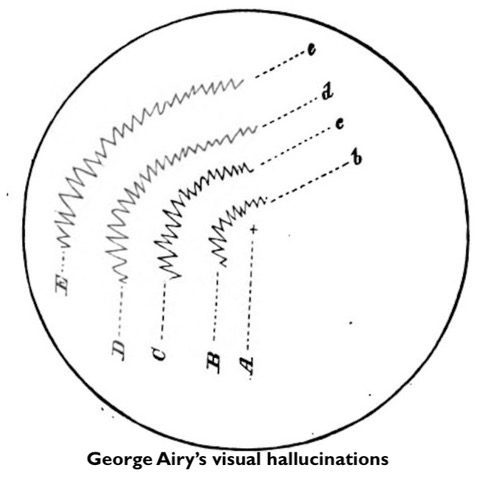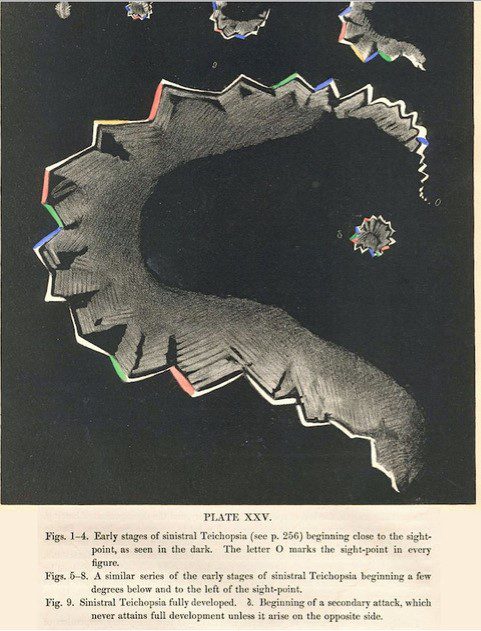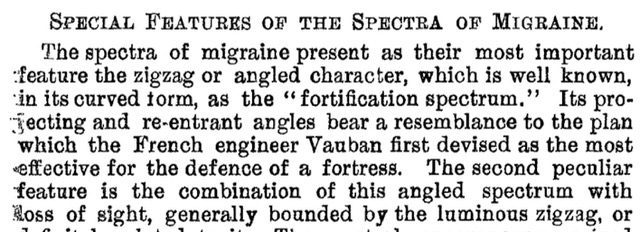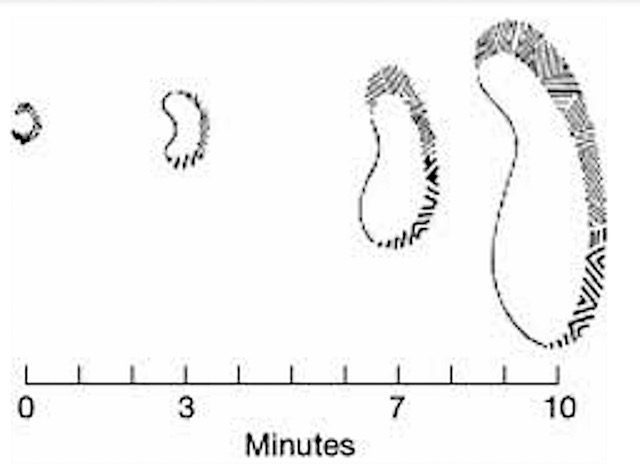JMS Pearce
Hull, England, United Kingdom
 |
| Fig 1. George Airy’s visual hallucinations from London, Edinb., and Dubl. Phil. Mag., ser. 4, 80: 19-21, 1865. reproduced in Jarcho S.11 |
Spleen sighs for ever on her pensive bed,
Pain at her side and megrim at her head.
— “Rape of the Lock”, Alexander Pope (1688-1744)
About one third of migraine sufferers experience an aura1 or warning that begins suddenly, lasts about twenty to forty minutes, and most commonly affects vision, and less often, sensation, movement, or speech.
Although migrainous attacks (hemicrania, megrim) have been described for millennia,2 the aura and its significance were not generally recognized. In 1784 John Fothergill (1712-80), the distinguished Quaker physician, recounted “fortifications” in his own migraine attacks:
A singular glimmering in the sight; objects swiftly changing their apparent position, surrounded with luminous angles, like those of a fortification. Giddiness comes on, head-ach and sickness.3
Samuel Auguste André David Tissot of Lausanne devoted an eighty-three-page chapter to migraine in his Traité des nerfs et de leurs maladie. He reported transient hemianopia, hemiplegia, and typical visual warnings in migraine.4 In 1825 Caleb Hillier Parry (1755-1822) described the visual aura in his popular Elements of Pathology and Therapeutics:
After a short time a corruscation of light in a zig-zag form plays rapidly backwards and forwards at one corner of what seems to be one eye only; but on trial is found to be common to both. [i.e. homonymous]5
 |
| Fig 2. Hubert Airy’s teichopsiae 1870. from Airy H.14 |
In France, la migraine appeared the 1830s texts of Louis-Florentin Calmeil and Pierre-Adolphe Piorry and included descriptions of a visual aura. Elsewhere they received little medical attention. William Hyde Wollaston MD in 1824, and the astronomers and physicists Francois Arago and Sir David Brewster in 1867, described attacks of obscurations, hemiopsy, or half-vision. In Britain, auras were seldom described until the astronomer Sir George Airy described his own symptoms in 1865.6 Five years later his son, Dr. Hubert Airy, more fully described his experience. Only then did it attract the medical studies and writings of Hughlings Jackson, Sir William Gowers, Peter W Latham, E. Du Bois Reymond, and Edward Liveing’s comprehensive discourse, On Megrim and Sick Headache (1873), and many others.
Many descriptions and illustrations of the visual aurae7,8 in literature and in works of art are of interest.9,10 There are frequent references to Lewis Carroll’s Alice, and to Saint Hildegard von Bingen’s (1098-1179) medical texts, visions, and prophecies; but the alleged migrainous nature of their experiences is doubtful.
Some of the most lucid descriptions have been provided, not by medical men, but by patients, natural philosophers, and astronomers.11
Sir George Biddell Airy FRS (1801-1892), Lucasian professor of mathematics and Astronomer Royal, was father of Hubert Airy. George Airy was known for his methodical brilliance, caustic personality, and scientific arguments with Charles Babbage and Michael Faraday. He described episodes of his visual obscurations, trembling “zigzags resembling those in the ornaments of a Norman arch,” and published drawings of them (Fig 1) five years before his son; but they did not presage a headache.12
 |
| Fig 3. Gowers: migraine aura. from Gowers WR.16 |
He also referred to a meeting of the British Association in June 1833 where he had Sir David Brewster and Mr. [John] Herschel as his breakfast guests. We may wonder what these three migrainous astronomers said of their common affliction.
Sir John Frederick William Herschel FRS (1792-1871) (son of William Herschel who discovered Uranus) was a founder of the Royal Astronomical Society. He described his experience “On sensorial vision” before the Philosophical and Literary Society of Leeds in 1858.13 Having no headache in his attacks, he was unaware that they were migrainous.
I was sitting one morning very quietly at my breakfast table doing nothing, and thinking of nothing, when I was startled by a singular shadowy appearance at the outside corner of the field of vision of the left eye. It gradually advanced into the field of view, and then appeared to be a pattern in straight-lined-angular forms, very much in general aspect like the drawing of a fortification, with salient and re-entering angles, bastions, and ravelins with some suspicion of faint lines of color between the dark lines.
Dr. Hubert Airy
 |
| Fig 4. Gowers’ illustration from Airy 1904. In: Gowers WR.16 |
Hubert Airy MD was a physician and amateur naturalist. Aged thirty-one, he described over fifteen years’ experience of perhaps a hundred episodes of scintillating scotoma of a pattern and duration similar to those of his father. He described the phenomena in exquisite detail and provided colored drawings of their appearances. In contrast to his father’s, Hubert Airy’s visual disturbance was followed by diffuse headache and nausea. His detailed description is meticulous; he refers to other articles and also reproduces Herschel’s account. Hubert Airy’s account was published in the Philosophical Transactions of the Royal Society in 1870, with drawings (Fig 2) that showed how his hallucination expanded over his visual field. He refers to an entry in his journal of 6 October 1854, in which as a schoolboy he recorded his first attacks:
I noticed it first by being unable to see the ‘t’ in “tan A” when I looked at the top. . . . like the spot you see after having looked at the sun. It went off in time leaving a most terrible headache behind it . . . at its height it seemed like a fortified town, with bastions all around it, coloured most gorgeously . . . the interior of the fortification was boiling or rolling about in a wonderful manner, as if it were some thick liquid all alive. It did not belong to one eye but to both . . .
If I put my pen into the space where there was this dimness, I could not see it at all. I could not even distinguish the colour of the ink at the end. All the interior of the fortification, so to speak, was boiling and rolling about in a most wonderful manner as if it was some thick liquid all alive. It did not belong only to one eye, but to both, the right eye having the most.14
Towards the end of the aura, he described headache: “It lasts for five or six hours or more, accompanied with slight nausea.” He introduced the name “teichopsia” (teichos town wall, opsis vision) “to represent the bastioned form of transient hemiopsia which I have been describing . . .” Airy (like Wollaston) correctly deduced that the source of his hallucinations was in his brain, not his eyes, and suggested a specific visual cortex, not widely recognized until the careful mapping of the visual cortex by Gordon Holmes derived from World War I injuries of the occiput.
Neurologists sought to integrate the astronomers’ observations and inferences into the clinical features.
Hughlings Jackson had arbitrarily classified one type of migraine: “Typical: one in which there is a ‘visual projection’, the well-known zigzag or ‘fortification’ outline is most common, within some cases a hemianopic area; then comes headache, most often frontal and one-sided, and lastly vomiting.”15 Anticipating the neural theories of Gowers, Lashley, and Leão, he regarded the headache of migraine as an epiphenomenon, the cerebral disorder being primary.
Gowers lavishly praised the work of Hubert Airy. He favored a neural rather than vascular etiology. His several case histories precisely expounded the visual aura.16 (Figs 3, 4) For Gowers, the words fortifications and teichopsiae were synonymous.
 |
| Fig 5. Lashley’s Evolution of the scintillating scotoma from Lashley KS.17 |
Forty years later, the Harvard psychologist Karl Lashley described his own migraine scotoma which started near the macula and enlarged, (Fig 5) retaining its shape:
The scotoma usually occurs first as a small blind or scintillating spot, subtending less than 1 degree, in or immediately adjacent to the foveal field. This spot rapidly increases in size and drifts away from the fovea toward the temporal field of one side. . . . these facts indicate that an excitatory process, in the case of scintillations, is initiated in one part of the visual cortex and spreads over an additional area. As the process spreads, activity at the point where it was initiated is extinguished, and the process of extinction also spreads over the same area at about the same rate as does the active process.17
Maps of the scotomas of ophthalmic migraine sketched at brief intervals during an attack suggest that a wave of intense excitation is propagated at a rate of about 3mm. per min. across the visual cortex. This wave is followed by complete inhibition of activity, with recovery progressing at the same rate.
—————
This links directly to Gowers’ earlier surmise and to Leão’s later investigations of spreading electrical depression of the cerebral cortex.18 The rate of spread of cortical inhibition corresponds closely to the calculated rate of cortical depression claimed by Lashley when he plotted his visual aurae.
These studies of the aura provide a basis for migraine initiated by a focal disturbance of neuronal function with spreading cortical inhibition.19 Whence this arises is not certain, but it accords well with Olesen’s subsequent observation of spreading oligaemia20—a secondary phenomenon due to the effect of neuronal disorder on its microcirculation and on regional blood flow. The characteristic form and development of migraine auras suggests that the underlying mechanism is a periodic disturbance of the cerebral cortex, probably the cortical spreading depression of Leão.18,21
If astronomers are more than usually prone to migraine, triggered by repeated exposures to contrasting lights of the night sky, or by their explorations of optics, is uncertain. Historically, they did however give us wonderfully descriptive minutiae of their own migrainous aurae, which in turn stimulated medical interest and investigation of migraine mechanisms.
End Notes
- Grossinger R. Migraine auras, when the visual world fails. Berkley, California, North Atlantic Books 2006.
- Pearce JMS. Historical aspects of migraine. J Neurol Neurosurg Psychiatry 1986;49:1097-1103.
- Fothergill J. Remarks on that complaint, commonly known under the name of the sick headach. Medical observations and inquiries by a society of physicians in London. Vol 6. Ist ed. London: T Cadell,1784:103-37.
- Tissot SA. De la migraine, Oeuvres de Monsieur Tissot, nouvelle edition augmentee et imprimee sous ses yeux 1790;13:383-8.
- Parry CH. Elements of Pathology and therapeutics. Vol 1. 2nd. Edition, Bath: Richard Cruttwell,1825:358.
- Eadie MJ. Hubert Airy, contemporary men of science and the migraine aura. J R Coll Physicians Edinb. 2009;39(3):263-7.
- Plant GT. The fortification spectra of migraine. Brit med J 1986;293:1613-7.
- Sacks O. Migraine. London, Faber and Faber; 1970. pp.72-118.
- McAuley JH. Migrainous scotomata in art. Hektoen Int J Fall, 2015.
- Podoll K, Ayles D. Inspired by migraine: Sarah Raphael’s ‘Strip!’ paintings. J R Soc Med. 2002;95(8):417-419. doi:10.1258/jrsm.95.8.417.
- Jarcho S. Migraine in Astronomers and ”Natural Philosophers” 1976.
- Airy, G. B. The Astronomer Royal on Hemiopsy. London, Edinb. and Dubl. Phil. Mag 1865; ser. 4, 30:19-21.
- Herschel JFW. Familiar lectures on scientific subjects. London: Alexander Strahan,1866:406.
- Airy H. On a distinct form of transient hemiopia. Philos Trans R Soc Lond 1870;160:247-70.
- Jackson JH. Remarks on the diagnosis and treatment of diseases of the brain. Brit Med J. 1888. reproduced In: Taylor J, ed. Selected writing of JH Jackson, London: Staples Press. Vol 2. 1958:153, 371 and 372.
- Gowers WR. Subjective sensations of sight and sound: Abiotrophy and other lectures. Trans Ophthal Soc UK 1904;15:1–39.
- Lashley KS. Patterns of cerebral integration indicated by the scotomas of migraine. Arch Neurol Psychiatry 1941;46:331–339.
- Leão AAP Spreading depression of activity in the cerebral cortex. J Neurophysiol 1944, 7: 359-90.
- Pearce JMS. Is Migraine Explained By Leao’s Spreading Depression? Lancet 1985;2:763-766.
- Olesen J, Tfelt-Hansen P, Henriksen L, Larsen B. The common migraine attack may not be initiated by cerebral ischaemia. Lancet 1981; ii: 438-40.
- Lauritzen M. Pathophysiology of the migraine aura: The spreading depression theory, Brain, Volume 117, Issue 1, February 1994, Pages 199–210.
JMS PEARCE, MD, FRCP, is emeritus consultant neurologist in the Department of Neurology at the Hull Royal Infirmary, England.
Sumer 2021 | Sections | Neurology

Leave a Reply